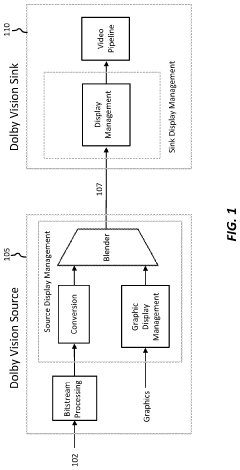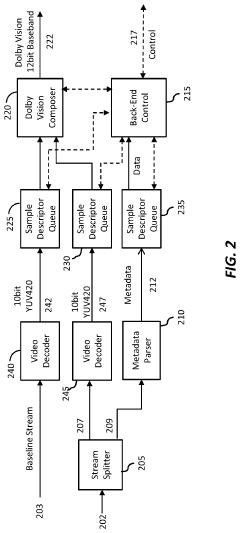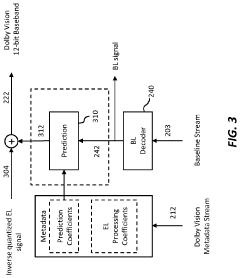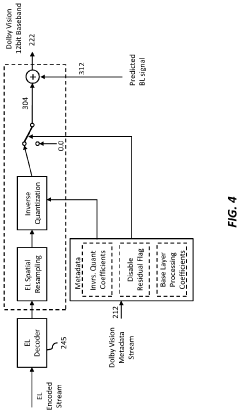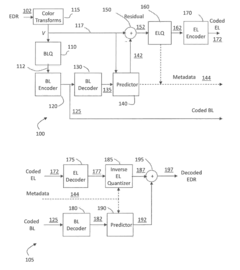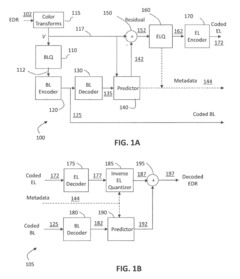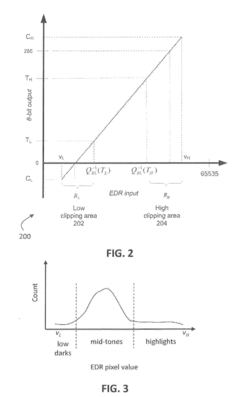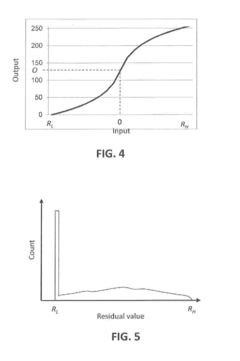Exploring Dolby Vision’s Synergy with Quantum Dot Displays
JUL 30, 20259 MIN READ
Generate Your Research Report Instantly with AI Agent
Patsnap Eureka helps you evaluate technical feasibility & market potential.
Dolby Vision and QD Display Evolution
Dolby Vision and Quantum Dot (QD) display technologies have evolved significantly over the past decade, each contributing to the advancement of visual experiences in their unique ways. Dolby Vision, introduced in 2014, revolutionized High Dynamic Range (HDR) content by offering dynamic metadata that optimizes each frame or scene. This technology enables a wider color gamut, higher peak brightness, and deeper blacks, resulting in more lifelike and immersive visuals.
Concurrently, Quantum Dot displays have made remarkable strides since their commercial introduction in the early 2010s. QD technology enhances color reproduction by utilizing semiconductor nanocrystals that emit light of specific wavelengths when excited. This allows for more precise and vibrant color representation, particularly in the red and green spectrums.
The synergy between Dolby Vision and QD displays began to emerge as manufacturers recognized the potential for combining these technologies. QD displays' ability to produce purer colors aligns perfectly with Dolby Vision's expanded color palette, creating a symbiotic relationship that pushes the boundaries of visual fidelity.
As QD technology matured, it branched into various implementations, including QD-enhanced LED-LCD displays and QD-OLED hybrid panels. These advancements allowed for even greater color accuracy and brightness, complementing Dolby Vision's capabilities. The evolution of both technologies has been driven by the increasing demand for superior image quality in home entertainment, professional content creation, and commercial applications.
Recent years have seen the integration of artificial intelligence and machine learning into both Dolby Vision processing and QD display manufacturing, further enhancing their performance. AI-driven algorithms in Dolby Vision can now more accurately predict and adjust HDR content, while machine learning has optimized the production and uniformity of Quantum Dots.
The convergence of these technologies has led to the development of displays that can reproduce a significantly larger portion of the visible color spectrum, approaching or exceeding the BT.2020 color space standard. This progression has been particularly beneficial for content creators, allowing them to capture and display a wider range of colors and contrasts than ever before.
Looking ahead, the continued evolution of Dolby Vision and QD displays promises even more impressive visual experiences. Research into new Quantum Dot materials and more sophisticated HDR algorithms suggests that future displays will offer even greater brightness, color accuracy, and energy efficiency, potentially revolutionizing fields such as virtual reality, augmented reality, and professional-grade monitors.
Concurrently, Quantum Dot displays have made remarkable strides since their commercial introduction in the early 2010s. QD technology enhances color reproduction by utilizing semiconductor nanocrystals that emit light of specific wavelengths when excited. This allows for more precise and vibrant color representation, particularly in the red and green spectrums.
The synergy between Dolby Vision and QD displays began to emerge as manufacturers recognized the potential for combining these technologies. QD displays' ability to produce purer colors aligns perfectly with Dolby Vision's expanded color palette, creating a symbiotic relationship that pushes the boundaries of visual fidelity.
As QD technology matured, it branched into various implementations, including QD-enhanced LED-LCD displays and QD-OLED hybrid panels. These advancements allowed for even greater color accuracy and brightness, complementing Dolby Vision's capabilities. The evolution of both technologies has been driven by the increasing demand for superior image quality in home entertainment, professional content creation, and commercial applications.
Recent years have seen the integration of artificial intelligence and machine learning into both Dolby Vision processing and QD display manufacturing, further enhancing their performance. AI-driven algorithms in Dolby Vision can now more accurately predict and adjust HDR content, while machine learning has optimized the production and uniformity of Quantum Dots.
The convergence of these technologies has led to the development of displays that can reproduce a significantly larger portion of the visible color spectrum, approaching or exceeding the BT.2020 color space standard. This progression has been particularly beneficial for content creators, allowing them to capture and display a wider range of colors and contrasts than ever before.
Looking ahead, the continued evolution of Dolby Vision and QD displays promises even more impressive visual experiences. Research into new Quantum Dot materials and more sophisticated HDR algorithms suggests that future displays will offer even greater brightness, color accuracy, and energy efficiency, potentially revolutionizing fields such as virtual reality, augmented reality, and professional-grade monitors.
Market Demand Analysis
The convergence of Dolby Vision and Quantum Dot displays represents a significant market opportunity in the high-end display technology sector. Consumer demand for superior visual experiences continues to drive innovation in this space, with Dolby Vision's advanced HDR technology and Quantum Dot's color enhancement capabilities emerging as key differentiators.
The global market for premium display technologies has shown robust growth in recent years, with a particular emphasis on technologies that can deliver enhanced color gamut, brightness, and contrast. This trend is especially pronounced in the high-end television and professional monitor segments, where consumers and professionals alike are willing to invest in superior visual quality.
Dolby Vision, as a leading HDR format, has gained significant traction in the content creation and distribution ecosystem. Major streaming platforms, film studios, and broadcasters have adopted Dolby Vision, creating a growing library of compatible content. This content ecosystem acts as a strong driver for consumer adoption of Dolby Vision-enabled displays.
Quantum Dot technology, on the other hand, has established itself as a premium solution for enhancing color performance in displays. The technology's ability to produce purer and more vibrant colors aligns well with the increasing consumer demand for lifelike and immersive visual experiences. The synergy between Dolby Vision and Quantum Dot displays addresses this demand by combining superior dynamic range with exceptional color reproduction.
Market research indicates that consumers are increasingly prioritizing picture quality when making purchasing decisions for televisions and monitors. The combination of Dolby Vision and Quantum Dot technology in a single display product has the potential to command a premium price point, appealing to discerning consumers and professionals who demand the best visual performance.
The professional content creation market also presents a significant opportunity for Dolby Vision and Quantum Dot synergy. As the demand for HDR content production grows, there is an increasing need for high-performance displays that can accurately represent the full range of colors and contrast in Dolby Vision content. This creates a niche market for professional-grade monitors that incorporate both technologies.
The automotive industry is another emerging market for advanced display technologies. As vehicles become more technologically sophisticated, there is growing interest in incorporating high-quality displays for infotainment systems and driver information displays. The combination of Dolby Vision and Quantum Dot technology could offer a competitive edge in this sector, providing enhanced visibility and color accuracy in varying lighting conditions.
The global market for premium display technologies has shown robust growth in recent years, with a particular emphasis on technologies that can deliver enhanced color gamut, brightness, and contrast. This trend is especially pronounced in the high-end television and professional monitor segments, where consumers and professionals alike are willing to invest in superior visual quality.
Dolby Vision, as a leading HDR format, has gained significant traction in the content creation and distribution ecosystem. Major streaming platforms, film studios, and broadcasters have adopted Dolby Vision, creating a growing library of compatible content. This content ecosystem acts as a strong driver for consumer adoption of Dolby Vision-enabled displays.
Quantum Dot technology, on the other hand, has established itself as a premium solution for enhancing color performance in displays. The technology's ability to produce purer and more vibrant colors aligns well with the increasing consumer demand for lifelike and immersive visual experiences. The synergy between Dolby Vision and Quantum Dot displays addresses this demand by combining superior dynamic range with exceptional color reproduction.
Market research indicates that consumers are increasingly prioritizing picture quality when making purchasing decisions for televisions and monitors. The combination of Dolby Vision and Quantum Dot technology in a single display product has the potential to command a premium price point, appealing to discerning consumers and professionals who demand the best visual performance.
The professional content creation market also presents a significant opportunity for Dolby Vision and Quantum Dot synergy. As the demand for HDR content production grows, there is an increasing need for high-performance displays that can accurately represent the full range of colors and contrast in Dolby Vision content. This creates a niche market for professional-grade monitors that incorporate both technologies.
The automotive industry is another emerging market for advanced display technologies. As vehicles become more technologically sophisticated, there is growing interest in incorporating high-quality displays for infotainment systems and driver information displays. The combination of Dolby Vision and Quantum Dot technology could offer a competitive edge in this sector, providing enhanced visibility and color accuracy in varying lighting conditions.
Technical Challenges
The integration of Dolby Vision with quantum dot displays presents several technical challenges that need to be addressed for optimal performance. One of the primary hurdles is the precise color management required to fully leverage the expanded color gamut offered by quantum dots. Dolby Vision's dynamic metadata system must be carefully calibrated to accurately map colors across the wider spectrum, ensuring that the enhanced color capabilities of quantum dots are utilized effectively without oversaturation or color distortion.
Another significant challenge lies in maintaining consistent peak brightness levels across different scenes while preserving the high dynamic range (HDR) that Dolby Vision is known for. Quantum dot displays can achieve higher brightness levels, but managing power consumption and heat dissipation becomes crucial to prevent degradation of the quantum dot material over time. This requires sophisticated algorithms and hardware solutions to balance peak luminance with energy efficiency and long-term display reliability.
The implementation of local dimming techniques also poses a technical hurdle. While quantum dot displays can offer improved contrast ratios, achieving the deep blacks and precise local dimming that Dolby Vision demands without introducing blooming or haloing effects remains a complex task. Engineers must develop advanced backlight control systems that can work in harmony with the quantum dot layer to deliver the desired contrast performance.
Furthermore, the challenge of color volume preservation across different brightness levels is amplified when combining Dolby Vision with quantum dot technology. As brightness increases, maintaining color accuracy and saturation becomes more difficult, requiring sophisticated color processing algorithms that can adapt in real-time to varying content and viewing conditions.
Interoperability and standardization present additional challenges. Ensuring that Dolby Vision-enabled content is correctly interpreted and displayed on quantum dot screens from various manufacturers requires robust communication protocols and standardized implementation guidelines. This is particularly important for maintaining consistent image quality across different devices and platforms.
Lastly, the cost-effective production of quantum dot displays that fully support Dolby Vision specifications is a significant hurdle. Balancing the advanced capabilities of both technologies with manufacturing scalability and consumer affordability requires innovative engineering solutions and strategic supply chain management. Overcoming these technical challenges will be crucial for widespread adoption and the realization of the full potential of combining Dolby Vision with quantum dot display technology.
Another significant challenge lies in maintaining consistent peak brightness levels across different scenes while preserving the high dynamic range (HDR) that Dolby Vision is known for. Quantum dot displays can achieve higher brightness levels, but managing power consumption and heat dissipation becomes crucial to prevent degradation of the quantum dot material over time. This requires sophisticated algorithms and hardware solutions to balance peak luminance with energy efficiency and long-term display reliability.
The implementation of local dimming techniques also poses a technical hurdle. While quantum dot displays can offer improved contrast ratios, achieving the deep blacks and precise local dimming that Dolby Vision demands without introducing blooming or haloing effects remains a complex task. Engineers must develop advanced backlight control systems that can work in harmony with the quantum dot layer to deliver the desired contrast performance.
Furthermore, the challenge of color volume preservation across different brightness levels is amplified when combining Dolby Vision with quantum dot technology. As brightness increases, maintaining color accuracy and saturation becomes more difficult, requiring sophisticated color processing algorithms that can adapt in real-time to varying content and viewing conditions.
Interoperability and standardization present additional challenges. Ensuring that Dolby Vision-enabled content is correctly interpreted and displayed on quantum dot screens from various manufacturers requires robust communication protocols and standardized implementation guidelines. This is particularly important for maintaining consistent image quality across different devices and platforms.
Lastly, the cost-effective production of quantum dot displays that fully support Dolby Vision specifications is a significant hurdle. Balancing the advanced capabilities of both technologies with manufacturing scalability and consumer affordability requires innovative engineering solutions and strategic supply chain management. Overcoming these technical challenges will be crucial for widespread adoption and the realization of the full potential of combining Dolby Vision with quantum dot display technology.
Current Implementation
01 Quantum dot technology for enhanced color gamut
Quantum dot displays utilize nanocrystal semiconductors to produce highly saturated colors, expanding the color gamut beyond traditional LCD capabilities. This technology enables more vibrant and accurate color reproduction, contributing to improved image quality in high-end displays.- Quantum dot technology for enhanced color and brightness: Quantum dot displays utilize nanocrystal semiconductors to produce vibrant colors and improved brightness. This technology enhances the overall image quality by providing a wider color gamut and higher luminance efficiency compared to traditional displays.
- Dolby Vision HDR implementation: Dolby Vision is a high dynamic range (HDR) technology that optimizes picture quality by enhancing contrast, color accuracy, and brightness. It uses dynamic metadata to adjust content on a scene-by-scene or frame-by-frame basis, resulting in more lifelike and immersive viewing experiences.
- Integration of quantum dots with Dolby Vision: The combination of quantum dot technology and Dolby Vision HDR creates synergistic effects on image quality. This integration allows for expanded color volume, improved peak brightness, and enhanced dynamic range, resulting in more realistic and vibrant visuals.
- Advanced color management and calibration: Sophisticated color management systems and calibration techniques are employed to optimize the performance of quantum dot displays and Dolby Vision-enabled devices. These systems ensure accurate color reproduction, consistent image quality across different content types, and proper HDR tone mapping.
- Display panel design and optimization: Innovative display panel designs and optimizations are developed to fully leverage the capabilities of quantum dot technology and Dolby Vision. These include advancements in backlight systems, light management films, and pixel structures to maximize color purity, contrast, and overall image quality.
02 Dolby Vision HDR implementation
Dolby Vision is an advanced HDR (High Dynamic Range) technology that enhances contrast and brightness in displays. It uses dynamic metadata to optimize each frame, resulting in more lifelike images with improved detail in both bright and dark areas of the screen.Expand Specific Solutions03 Integration of AI for image quality enhancement
Artificial intelligence algorithms are being incorporated into display technologies to analyze and optimize image quality in real-time. These AI systems can adjust color, contrast, and sharpness based on content and viewing conditions, further improving the visual experience.Expand Specific Solutions04 Advanced backlight control systems
Sophisticated backlight control mechanisms are being developed to enhance local dimming capabilities in LED-backlit displays. These systems allow for more precise control over brightness in different areas of the screen, improving contrast ratios and reducing blooming effects.Expand Specific Solutions05 Color management and calibration techniques
Advanced color management systems and calibration techniques are being implemented to ensure accurate color reproduction across different content types and viewing environments. These systems work in conjunction with quantum dot technology and HDR processing to maintain color fidelity and consistency.Expand Specific Solutions
Key Industry Players
The synergy between Dolby Vision and Quantum Dot displays represents a cutting-edge development in display technology, currently in its early growth stage. The market for this technology is expanding rapidly, driven by increasing demand for high-quality visual experiences in consumer electronics. While the market size is still relatively modest, it's projected to grow significantly in the coming years. Technologically, the integration of Dolby Vision with Quantum Dot displays is advancing quickly, with companies like Samsung Display, LG Display, and TCL China Star Optoelectronics leading the way. These firms are investing heavily in research and development to refine the technology, improve performance, and reduce production costs, indicating a maturing but still evolving technological landscape.
BOE Technology Group Co., Ltd.
Technical Solution: BOE has been developing advanced Quantum Dot display technologies that are compatible with Dolby Vision. Their approach focuses on improving the efficiency and stability of Quantum Dot materials, allowing for better color purity and longevity. BOE's Quantum Dot displays can achieve a color gamut coverage of up to 108% NTSC, significantly wider than traditional LCD panels[9]. When combined with Dolby Vision, these displays can offer peak brightness levels of up to 1600 nits, providing an immersive HDR experience. BOE has also been working on reducing the power consumption of their Quantum Dot displays, making them more energy-efficient while maintaining high performance with Dolby Vision content[10].
Strengths: Wide color gamut, energy efficiency, and competitive pricing. Weaknesses: Lower peak brightness compared to some competitors and less brand recognition in some markets.
Samsung Electronics Co., Ltd.
Technical Solution: Samsung has pioneered the integration of Quantum Dot technology with Dolby Vision in their QLED TV lineup. Their approach utilizes a layer of Quantum Dots to enhance color volume and brightness, working in tandem with Dolby Vision's dynamic metadata. Samsung's implementation allows for peak brightness levels of up to 2000 nits in their high-end models[4]. The company has also developed AI-powered processors that optimize Dolby Vision content in real-time, adjusting parameters based on ambient lighting conditions and content type[5]. Samsung's QLED TVs with Dolby Vision support can display 100% of the DCI-P3 color space, ensuring exceptional color accuracy and vibrancy[6].
Strengths: Advanced AI-powered optimization, high peak brightness, and excellent color accuracy. Weaknesses: Premium pricing and potential oversaturation in some content.
Core Innovations
Layered representation and delivery of high dynamic range video
PatentActiveUS20190373290A1
Innovation
- The implementation of a layered representation and delivery system for HDR video, utilizing Dolby Vision technology, which includes a base layer and enhancement layer, along with metadata processing to reconstruct HDR signals, ensuring seamless playback on compatible displays.
Layered Decomposition of Chroma Components in EDR Video Coding
PatentActiveUS20160065975A1
Innovation
- A dual-layer EDR video encoder employs joint adaptation of base layer and enhancement layer quantizers, optimizing parameter selection to minimize distortion and bit requirements, allowing for efficient coding and decoding of EDR video streams that can be rendered on both legacy and HDR displays.
Standardization Efforts
The standardization efforts for Dolby Vision and Quantum Dot Display technologies have been crucial in ensuring interoperability, quality consistency, and widespread adoption across the industry. These efforts have been primarily driven by industry consortiums, standards bodies, and key technology providers.
Dolby Laboratories has been at the forefront of standardizing Dolby Vision, working closely with the Ultra HD Alliance and other industry partners. The company has established a comprehensive certification program for Dolby Vision, ensuring that displays and content meet specific performance criteria. This standardization process includes guidelines for color volume, brightness levels, and dynamic range, which are essential for maintaining the integrity of Dolby Vision content across different devices.
In parallel, the Quantum Dot Display technology has seen significant standardization efforts led by organizations such as the International Electrotechnical Commission (IEC) and the Society for Information Display (SID). These bodies have been working on developing standards for measuring and characterizing Quantum Dot performance, including metrics for color gamut, efficiency, and longevity.
The convergence of Dolby Vision and Quantum Dot Display technologies has necessitated collaborative standardization efforts. Industry leaders have been working towards establishing common ground in areas such as color space mapping, HDR metadata interpretation, and display calibration methodologies. These efforts aim to ensure that Quantum Dot Displays can fully leverage the capabilities of Dolby Vision content, providing consumers with a consistent and high-quality viewing experience.
One of the key challenges in standardization has been addressing the diverse range of Quantum Dot implementations across different manufacturers. To tackle this, standardization bodies have focused on creating flexible frameworks that can accommodate various Quantum Dot technologies while still maintaining consistent performance benchmarks.
The standardization process has also involved the development of test patterns and measurement protocols specifically designed to evaluate the synergy between Dolby Vision and Quantum Dot Displays. These tools enable manufacturers and content creators to optimize their products for maximum compatibility and performance.
Looking ahead, ongoing standardization efforts are focusing on future-proofing the integration of Dolby Vision with evolving Quantum Dot technologies. This includes considerations for emerging display form factors, such as flexible and transparent displays, as well as advancements in Quantum Dot materials that may offer even wider color gamuts and higher efficiencies.
Dolby Laboratories has been at the forefront of standardizing Dolby Vision, working closely with the Ultra HD Alliance and other industry partners. The company has established a comprehensive certification program for Dolby Vision, ensuring that displays and content meet specific performance criteria. This standardization process includes guidelines for color volume, brightness levels, and dynamic range, which are essential for maintaining the integrity of Dolby Vision content across different devices.
In parallel, the Quantum Dot Display technology has seen significant standardization efforts led by organizations such as the International Electrotechnical Commission (IEC) and the Society for Information Display (SID). These bodies have been working on developing standards for measuring and characterizing Quantum Dot performance, including metrics for color gamut, efficiency, and longevity.
The convergence of Dolby Vision and Quantum Dot Display technologies has necessitated collaborative standardization efforts. Industry leaders have been working towards establishing common ground in areas such as color space mapping, HDR metadata interpretation, and display calibration methodologies. These efforts aim to ensure that Quantum Dot Displays can fully leverage the capabilities of Dolby Vision content, providing consumers with a consistent and high-quality viewing experience.
One of the key challenges in standardization has been addressing the diverse range of Quantum Dot implementations across different manufacturers. To tackle this, standardization bodies have focused on creating flexible frameworks that can accommodate various Quantum Dot technologies while still maintaining consistent performance benchmarks.
The standardization process has also involved the development of test patterns and measurement protocols specifically designed to evaluate the synergy between Dolby Vision and Quantum Dot Displays. These tools enable manufacturers and content creators to optimize their products for maximum compatibility and performance.
Looking ahead, ongoing standardization efforts are focusing on future-proofing the integration of Dolby Vision with evolving Quantum Dot technologies. This includes considerations for emerging display form factors, such as flexible and transparent displays, as well as advancements in Quantum Dot materials that may offer even wider color gamuts and higher efficiencies.
Energy Efficiency Impact
The integration of Dolby Vision technology with quantum dot displays has significant implications for energy efficiency in display systems. Quantum dot displays are already known for their superior color performance and energy-saving capabilities compared to traditional LED-backlit LCD displays. When combined with Dolby Vision's advanced HDR technology, the synergy between these two innovations can lead to further improvements in energy efficiency.
Quantum dot displays utilize nanocrystals that emit light at specific wavelengths when excited by energy. This precise color emission allows for more efficient use of backlight energy, as less light is wasted through color filters. When Dolby Vision's dynamic metadata is applied to quantum dot displays, it enables even more precise control over brightness and color output on a scene-by-scene or even frame-by-frame basis.
This granular control allows the display to optimize its power consumption based on the content being shown. In darker scenes, the display can reduce its overall brightness while maintaining excellent contrast and color accuracy. Conversely, in brighter scenes, the display can selectively boost brightness only where needed, rather than increasing the backlight across the entire screen.
The combination of Dolby Vision and quantum dot technology also enables displays to achieve higher peak brightness levels without proportionally increasing power consumption. This is particularly beneficial for HDR content, where high brightness is crucial for delivering a compelling visual experience. By leveraging the efficiency of quantum dots and the intelligent tone mapping of Dolby Vision, displays can produce stunning HDR images while minimizing energy usage.
Furthermore, the wide color gamut capabilities of quantum dot displays align well with Dolby Vision's support for expanded color spaces. This synergy allows for more efficient color reproduction, as the display can accurately produce a wider range of colors without relying on power-hungry color-enhancing techniques often used in traditional displays.
In practical terms, this collaboration between Dolby Vision and quantum dot technology can lead to significant energy savings in various display applications. For consumer electronics such as televisions and mobile devices, it translates to longer battery life and reduced electricity costs. In commercial settings like digital signage or professional monitors, the energy efficiency improvements can contribute to lower operational expenses and a reduced environmental footprint.
As display technologies continue to evolve, the partnership between Dolby Vision and quantum dot displays represents a promising direction for achieving both superior image quality and enhanced energy efficiency. This combination not only addresses the growing demand for high-performance displays but also aligns with global efforts to reduce energy consumption in consumer and professional electronics.
Quantum dot displays utilize nanocrystals that emit light at specific wavelengths when excited by energy. This precise color emission allows for more efficient use of backlight energy, as less light is wasted through color filters. When Dolby Vision's dynamic metadata is applied to quantum dot displays, it enables even more precise control over brightness and color output on a scene-by-scene or even frame-by-frame basis.
This granular control allows the display to optimize its power consumption based on the content being shown. In darker scenes, the display can reduce its overall brightness while maintaining excellent contrast and color accuracy. Conversely, in brighter scenes, the display can selectively boost brightness only where needed, rather than increasing the backlight across the entire screen.
The combination of Dolby Vision and quantum dot technology also enables displays to achieve higher peak brightness levels without proportionally increasing power consumption. This is particularly beneficial for HDR content, where high brightness is crucial for delivering a compelling visual experience. By leveraging the efficiency of quantum dots and the intelligent tone mapping of Dolby Vision, displays can produce stunning HDR images while minimizing energy usage.
Furthermore, the wide color gamut capabilities of quantum dot displays align well with Dolby Vision's support for expanded color spaces. This synergy allows for more efficient color reproduction, as the display can accurately produce a wider range of colors without relying on power-hungry color-enhancing techniques often used in traditional displays.
In practical terms, this collaboration between Dolby Vision and quantum dot technology can lead to significant energy savings in various display applications. For consumer electronics such as televisions and mobile devices, it translates to longer battery life and reduced electricity costs. In commercial settings like digital signage or professional monitors, the energy efficiency improvements can contribute to lower operational expenses and a reduced environmental footprint.
As display technologies continue to evolve, the partnership between Dolby Vision and quantum dot displays represents a promising direction for achieving both superior image quality and enhanced energy efficiency. This combination not only addresses the growing demand for high-performance displays but also aligns with global efforts to reduce energy consumption in consumer and professional electronics.
Unlock deeper insights with Patsnap Eureka Quick Research — get a full tech report to explore trends and direct your research. Try now!
Generate Your Research Report Instantly with AI Agent
Supercharge your innovation with Patsnap Eureka AI Agent Platform!
